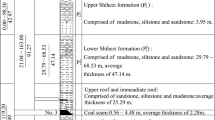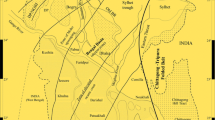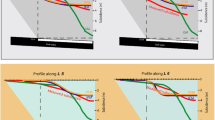Abstract
Transformation in surface topography is a common phenomenon caused due to underground mining. With a view to focus outward, underground mining at a depth of 410 m although earlier considered as mothball is indispensable as on date to meet the production target. Subsidence investigation has been carried out over longwal panel no. 1 in Adriyala mine of Singareni Collieries Company Limited (SCCL) located in Godavari Valley Coalfield. The rate of face advance varied between 2.7 and 4.8 m/day. The present study envelops cementing relation of subsidence due to underground mining by longwall method with the active and old dumps, partially covered over the panel. Symmetric subsidence profile has been observed across the panel with higher angle of draw in dip side. Resettlement of dump led to higher vertical displacement and found to be an indispensable investigation for stability viewpoint. The angle of draw has been analyzed to be a controlling parameter with respect to the rate of face advance. The impact of subsidence on surface has been evaluated by constructing walls at maximum possible tensile zones and development of cracks after subsidence has been observed. Hydrogeological study has also been conducted, from seepage viewpoint, to evaluate the extent of damage in the strata for safe underground working. The investigation has been conducted during and after mining, with and without release of canal water, to assess the influence of seepage in ground. The assorted subsidence and hydrogeological investigations can be applied to interpret the extent of damage and for comprehensive understanding of the trait of cracks on the surface, in the strata and their continuity thereof.













Similar content being viewed by others
Abbreviations
- SCCL:
-
Singareni Collieries Company Limited
- Ad :
-
dynamic angle of draw
- Fa :
-
rate of face advance
References
Pathegama G R, Zhao J, Ju M, Silva R V S D, Tharaka D R and Bandara A K M S 2017 Opportunities and challenges in deep mining: a brief review. Eng. Aug. 3(4): 546–551
Anonymous 2018 Indian minerals yearbook (Part-III: Mineral Reviews). 56th edition, IBM Nagpur 29
Anonymous 2017 Indian coal and lignite resources-2017. Geol. Society India. Natural energy resources, Mission-IIB 2017:46
Mukherjee S and Pahari D P 2019 Underground and opencast coal mining methods in India: a comparative assessment. Space Culture India 7(1):39–55. https://doi.org/10.20896/saci.v7i1.395
Mitra R and Saydam S 2012 Surface coal mining methods in Australia. Mining Methods, Prof. Turgay Onargan (Editor), ISBN: 978-953-51-0289-2
Zehirov S, Kaykov D and Koprev I 2017 A review of combining open-pit and underground mining methods around the world. J. Min. Geol Sci. Part II Min. Technol. Miner. Process. 60: 17–20
Adelsohn E, Iannacchione A and Winn R 2020 Investigations on longwall mining subsidence impacts on Pennsylvania highway alignments. Int. J. Min. Sci. Tech. 30: 85–92
Ju J and Xu J 2015 Surface stepped subsidence related to top-coal caving longwall mining of extremely thick coal seam under shallow cover. Int. J. Rock Mech. Min. 78: 27–35
Ren G and Li J 2008 A study of angle of draw in mining subsidence using numerical modeling techniques. Electron. J. Geotech. Eng. 13: 1–14
Fangtian W, Cun Z, Xiaogang Z and Qi S 2015 Overlying strata movement rules and safety mining technology for the shallow depth seam proximity beneath a room mining goaf. Int. J. Min. Sci. Tech. 25: 139–143
Booth C, Spande E and Pattee C 1998 Positive and negative impacts of longwall mine subsidence on a sandstone aquifer. Env. Geol. 34: 223–233
Holla L and Barclay E 2000 Mine subsidence in the Southern Coalfield, NSW, Australia. Mineral Resources of NSW, Sydney
Reddish D J, Yao X L, Benbia A, Cain P and Forrester D J 1994 Modelling of caving over the Lingan and Phalen mines in the Sidney coalfield, Cape Breton. In: Proceedings of the 5th International Mine Water Congress, Nottingham (U.K.) September105–124
Whetton J T and King H J 1961 The time factor in mining subsidence. Clark G B (Editor), In: Proceedings of the International Symposium on Mining Research, Rolla, Missouri 2:521–539
National Coal Board 1963 Principles of subsidence engineering. Inform. Bull. 63(240): 27
Kratzsch H 1989 Mining Subsidence Engineering. Springer, Berlin, p 543
Whittaker B N and Reddish D J 1989 Subsidence—occurrence, prediction and Control. Elsevier Science Publishers, Basel, p 541
Yao X L, Whittaker B N and Reddish D J 1991 Influence of overburden mass behavioural properties on subsidence limit characteristics. Int. J. Min. Sci. Tech. 13(2): 167–173. https://doi.org/10.1016/0167-9031(91)91328-F
Sasaoka T, Takamoto H, Shimada H, Oya J, Hamanaka A and Matsui K 2015 Surface subsidence due to underground mining operation under weak geological condition in Indonesia. J. Rock. Mech. Geotech. 7: 337–344
Abel J F Jr and Lee F T 1980 Subsidence potential in shale and crystalline rocks. U.S. Geological Survey Open-File Report 52: 80–1072
Peng S S 1992 Surface subsidence engineering. Society for Mining, Metallurgy and Exploration, Littleton, p 161
Acknowledgements
Authors would like to thank the Director, CSIR-Central Institute of Mining and Fuel Research, Dhanbad, for permitting to publish the research article. The mine management is gratefully acknowledged for facilitating field investigation and providing relevant details. The views expressed in this paper are those of the authors and not necessarily of the organization they represent.
Author information
Authors and Affiliations
Corresponding author
Rights and permissions
About this article
Cite this article
Prakash, A., Kumar, A., Verma, A. et al. Trait of subsidence under high rate of coal extraction by longwall mining: some inferences. Sādhanā 46, 216 (2021). https://doi.org/10.1007/s12046-021-01747-5
Received:
Revised:
Accepted:
Published:
DOI: https://doi.org/10.1007/s12046-021-01747-5




